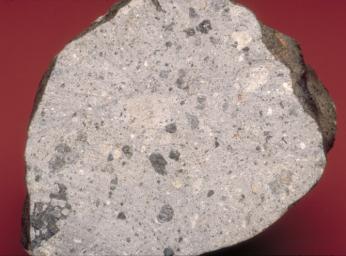
|
Rocks from Vesta – Part 2: Howardites
- Click the image above for a larger view
- Full-Res JPEG (1800 x 1333) (343.9 kB)
- Full-Res TIFF (1800 x 1333) (7.2 MB)
Caption:
The HED (howardite, eucrite and diogenite) meteorites are a large group of meteorites believed to originate from Vesta, a hypothesis that is consistent with current Dawn observations. Howardites are regolith breccia rocks, meaning that they formed through the grinding and fusion of rock and dust that occurs during meteor impacts on the surface of Vesta. Howardites are comprised of fragments of eucrite and diogenite of varying grain sizes, which can be seen in this picture of the Bununu howardite. This sample weighs 217 grams and was recovered in 1942 in Africa. Along with fragments of eucrite and diogenite, some howardites also contain solar wind implanted noble gasses, which confirms that they once resided on the surface of their parent body. This makes howardites a good laboratory analog for spectral and chemical measurements that will be made of the Vestan surface by Dawn.
Background Info:
The Dawn mission to Vesta and Ceres is managed by NASA's Jet Propulsion Laboratory, a division of the California Institute of Technology in Pasadena, for NASA's Science Mission Directorate, Washington D.C. UCLA is responsible for overall Dawn mission science. Dawn's VIR was provided by ASI, the Italian Space Agency and is managed by INAF, Italy's National Institute for Astrophysics, in collaboration with Selex Galileo, where it was built.
More information about Dawn is online at http://www.nasa.gov/dawn and http://dawn.jpl.nasa.gov .
Cataloging Keywords:
| Name | Value | Additional Values |
|---|---|---|
| Target | 4 Vesta | |
| System | Main Belt | |
| Target Type | Asteroid | |
| Mission | Dawn | |
| Instrument Host | Dawn | |
| Host Type | Orbiter | |
| Instrument | ||
| Detector | ||
| Extra Keywords | Color, Dust, Impact, Infrared | |
| Acquisition Date | ||
| Release Date | 2011-12-03 | |
| Date in Caption | ||
| Image Credit | NASA/JPL-Caltech/Hap McSween (University of Tennessee), and Andrew Beck and Tim McCoy (Smithsonian Institution) | |
| Source | photojournal.jpl.nasa.gov/catalog/PIA15137 | |
| Identifier | PIA15137 | |
